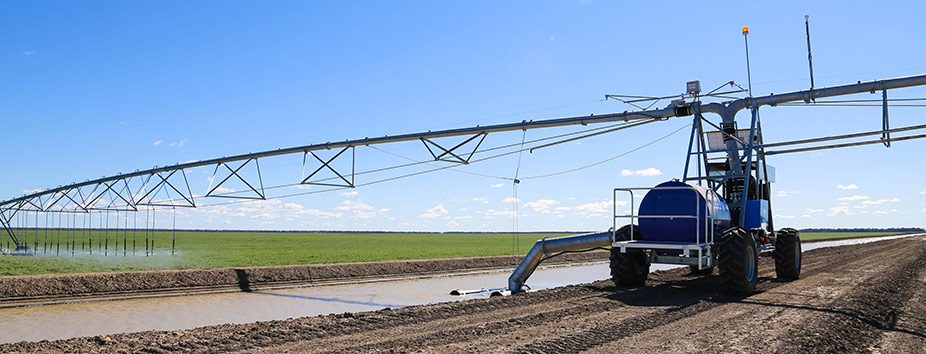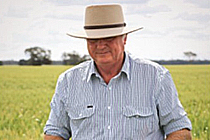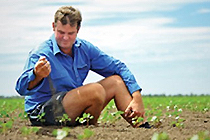Adding value to the bottom line

Reardon Farms and Corish Farms have both used Queensland's water use efficiency program to minimise the losses of irrigation water.

Reardon Farms and Corish Farms have both used Queensland's water use efficiency program to minimise the losses of irrigation water.
At Talwood, Queensland, Robert and Jennie Reardon have used Queensland’s Healthy HeadWaters water use efficiency project to minimise the losses of irrigation water. The 2015 Monsanto Cotton Grower of the Year has amassed 25,000ha of farmland—of which 6072ha is under irrigation—since moving to Talwood with his wife, Jennie, in 1990.
With support from the Healthy HeadWaters water use efficiency project, the Reardon family has made substantial investments in minimising water losses and increasing production efficiency and sustainability.
On completion this development has:

The idea behind increasing the dam storage size is to raise the height of the walls from 5m to 8m, which increases the total capacity but maintains the same surface area, which is exposed to the sun and therefore subject to evaporation. This reduces the evaporation losses from about 48 per cent to 25 per cent per annum, giving a water saving of at least 23 per cent of the total storage capacity. The other benefit is this: Raising the storage walls means a greater proportion of the stored water can be gravity-fed out rather than pumped, which in turn saves on diesel costs. As a long-term solution, large rock was also transported in and added to the inside of the storage for erosion control, to reduce ongoing maintenance costs.
The other part of the development program was to introduce alternative irrigation methods, which can provide better efficiencies and additional scope to diversify into different crops.
The bankless channel development has been introduced to allow faster irrigation times, which reduces the time the water is spread over the field and exposed to the sun, therefore reducing evaporation losses.
Instead of irrigation water being hand-siphoned out of head ditches and creeping down furrows between rows, the bankless method means just opening a gate and allowing water to briefly flood the field, before it is collected for recycling.
Because the irrigations are faster, there is also a reduction in deep drainage losses, as the water doesn’t have time to soak past a depth of 100cm, which keeps the moisture in the effective root zone of the plants.
The investment in four lateral irrigators has also created efficiencies in this area, as they are effectively a large sprinkler that allows for the exact amount of water to be applied relative to the plants’ growth stage and size. Therefore, when the crop is young and has a small root zone, only enough water to maintain its growth needs to be applied. Whereas in flood irrigation, a full profile of moisture is applied, regardless of the plants’ growth stage.
By the end of the growing season a saving of up to 30 per cent can be achieved using this method. Both these forms of irrigation also provide other benefits such as labour reductions and increased machine operation efficiencies. As part of this development program new pump stations were installed and a large emphasis was put on engine and pump efficiency. The engine sizes and pump types were selected specifically for each purpose, with the main focus being fuel efficiency.
Some of the new computerised engines installed now use up to half the fuel of the older models—30L/h versus 60L/h—which, on an operation the size of the Reardons’, translates to a considerable amount of fuel.
Increasing the total area of irrigation and introducing these new systems has allowed the business to rotate cotton with other crops such as cereals and pulses, which from prior on-farm trials and research resulted in the cotton yield increasing by 2.5 bales/ha and using 1.3ML/ha less water over the previous system of growing cotton back-to-back.
All of these factors combined are designed to make the business more diverse and sustainable, both economically and environmentally.
Two-thousand megalitres — two million cubic metres—is a lot of water to add to the budget of an irrigation farm. The Corish family did it without taking an extra drop from elsewhere. Leveraging the Healthy HeadWaters water use efficiency project, the southern Queensland irrigated farm business tackled an inefficient area on one of its farms in the Talwood area.
The biggest result came from converting a shallow water storage covering 250ha (in an area with 2m of evaporation a year, which made it as much an evaporation pan as storage) and condensing the same capacity into about 70ha by greatly increasing the storage’s depth.
As a result, says Simon Corish, water savings of 2000ML a year have been made on a storage system that previously lost 3200ML annually to evaporation and envirotranspiration.
The other project was to convert 450ha—some of it ground reclaimed from the wide, shallow storage—from flood irrigation to the bankless system, along with development to improve rotation on the farm. The conversion has demonstrated savings of about 1.5ML/ha on a cotton crop.
“We haven’t harvested the crop yet, but the yield is certainly comparable with flood irrigation, and the labour efficiency and machinery efficiency is extraordinary,” Simon says. “We haven’t had to employ another person, yet we can irrigate 450ha more.”
The Corish family, whose holdings spread around Goondiwindi to Mungindi and Talwood, has never been shy of leadership. Simon’s father, Peter, was President of the National Farmers’ Federation; his brother, Nigel, is a Nuffield Scholar and former Cotton Grower of the Year; and Simon is currently Chair of Cotton Australia.

Nevertheless, Simon said it took him about five years to take the plunge on water efficiency programs because of the daunting costs. Having seen the results, though, he’s a convert.
“I’ve already started looking at some of our other farms and doing a whole-farm assessment to find the areas that aren’t performing as well. I’m looking at the budgets and thinking about reconfiguring parts of the operation with our own money.”
All irrigation farms have areas that growers know don’t deliver optimal return on investment. But the costs of developing new land are substantial, and rising, Simon says, so often the best way to increase productivity is to wring more from existing development.
There is a growing smorgasbord of options on the table. Growers can invest in upgrading the standard flood system to increase its efficiency, or they can pick up on some of the newer irrigation technologies, such as bankless or lateral-move irrigators.
“I think once growers see some of the numbers and the performance of some of these new irrigation systems, they will tend to lean that way,” Simon says.
This may eventually be judged as the most positive outcome of the government’s water use efficiency program, he thinks. By subsidising growers to try new technologies, the program has shown that water use efficiency isn’t just an ideal but something that adds enough value to a farm’s bottom line to pursue without support.
The Queensland Government’s Healthy HeadWaters water use efficiency project aims to help irrigators, communities and the environment in the Queensland Murray–Darling Basin by funding irrigation infrastructure and supporting projects.
Two more rounds of the project are planned for 2016 and round 10 is currently open for applications. Applications close on the last business day of each month from January to June 2016.
For more information visit Healthy Headwater website